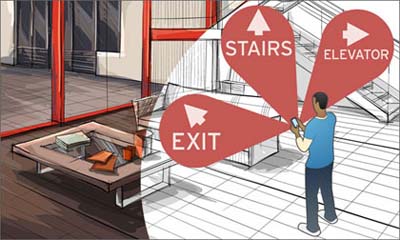GPS has been a very useful technology for positioning users in an outdoor environment. However, telecommunication researchers have not been able to attain GPS-like accuracy indoors. In the last few years,companies like Google, Microsoft, Qualcomm and Apple have focused on indoor localization. Research teams at universities also have attacked the problem. Practical solutions are converging, and a localization application is expected to be in the market soon.

One solution to indoor tracking was developed by a research team at Duke University. The Duke team’s key idea for accurate indoor localization is similar to how people use landmarks in outdoor environments. Their technique takes advantage of ‘invisible’ landmarks in indoor environments that a mobile phone can sense using its built-in sensors. Example landmarks could be distinct motion signatures created by elevators, because the phone can detect motion, or certain dead spots where WiFi or 3G signals are absent.
Once such an invisible landmark is sensed, the phone can infer its current location, and then track its path from that point forward using motion sensors (such as accelerometers, compasses and gyroscopes). The tracking may become inaccurate over time, but as the phone hits other landmarks, it continuously corrects its location.
The application has been dubbed UnLoc, short for unsupervised indoor localization. UnLoc does not require any pre-deployment effort, often called “wardriving.” Wardriving is a process where every location needs to be visited and calibrated to create a database of per-location fingerprints. This is often expensive especially because it needs to be done periodically.
UnLoc is less battery-hungry than GPS, which can drain a phone’s battery in a matter of hours. The use of energy-efficient inertial sensors, available in almost all smartphones, allows a user to track location continuously through the day.
UnLoc achieved 1.6 meter accuracy on average in tests conducted in the Northgate shopping mall in Durham, N.C., as well as in the computer science and engineering buildings on Duke’s campus.
The development of the UnLoc technique was supported by the National Science Foundation and Google.